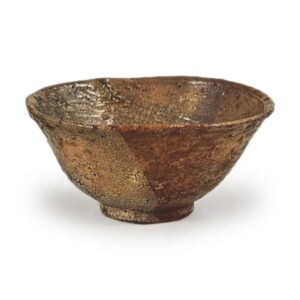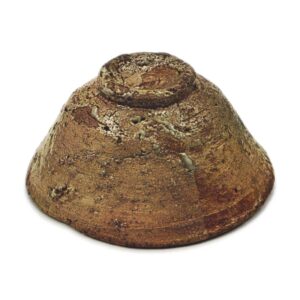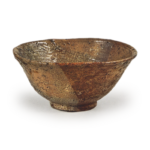

Height: 6.8 to 7.2 cm
Diameter: 13.7 to 14.3 cm
Outer diameter of foot ring: 5.5 to 5.8 cm
Height of foot ring: 0.8 cm
There are two tea bowls known as Chigusa Irahō. One is this tea bowl, which has been passed down in the Hirase family. The other is said to have belonged to the Matsudaira Fumai clan, and both are highly regarded as the most exquisite and well-known Iroha tea bowls from ancient times.
They are thought to be relatively old works among Iroha tea bowls, but it is not thought that they date back to before the Bunroku-Keicho period.
The name of the Chigusa Iroha tea bowl comes from the fact that it was owned by the Chigusa family of ministers (the first generation, Arinobu, lived from the end of the Momoyama period to the beginning of the Edo period, and the second generation, Arihi, died in 1692).
The reason this tea bowl captivates the hearts of tea ceremony enthusiasts is the richness of the glaze, which is full of variety. The glaze is applied in a so-called “katamigawari” style, with a thin, brownish-tea-colored irapo glaze on one side and a loquat-colored well glaze on the other. Furthermore, on the inside of the bowl, two coats of well glaze have been applied in a bold, sweeping pattern, making the interior scenery even richer. The well glaze on one side is applied diagonally from the rim to the base, as can be seen in the illustration, and the clear, asymmetrical application of the glaze gives the piece a refined elegance. However, from the foot to the base, the surface is rough and cracked, with large and small cracks, giving the piece a dignified and stately appearance. Furthermore, the well glaze is tinged with a bluish hue in some places, and crystal-like glaze pools can be seen in several places, giving the overall piece an indescribable charm.
The cut-out inside the foot ring is relatively shallow, and the foot ring is slightly rounded. The waist is slightly tight, and the upper part of the body gradually curves outwards, becoming more strongly curved at the rim around the mouth. The mouth is sharply shaped with a so-called “higuchi” (a narrow groove around the rim of the bowl), which gives the soft-looking shape a sharp finish, and there are some bevels. The inside of the bowl is not nearly as concave as a tea bowl, but is moderately rounded and deep. However, the overall appearance is not one of a bowl brimming with power, but rather one of a warm and graceful presence. In addition, there are small and large stone flakes appearing in several places, and there are also some cracks in the mouth area caused by the stone flakes. There is also a spot where the glaze has flaked off the waist, but the unglazed clay beneath it is rough and reddish brown in color, with a high iron content. It is thought that this Hirose family tea bowl passed from the Chigusa family to Ogi Zenzaemon (also written as Omoto Kichiemon), and then to the wealthy Togaki family, the wealthiest merchant family in Edo between the Genroku and Genbun eras, and then to the Ueda Koheiji family, and then to the Chigusaya Hirose family in Osaka when the Togaki family was beginning to decline in the Temmei and Kansei eras. When it was in the Fuyuki family, there is a mention of “Chigusa Ibo, Ogi Zenzaemon, Fuyuki Koheiji” in the “Chuko Meibutsu Ki” written by Sakamoto Shusai.
The Hirase family, who owned this tea bowl, were originally from Chikusa in Banshu (Hyogo Prefecture), and they called themselves the Chikusa family in reference to this, but when they acquired the Chikusa Iroha, they were overjoyed, and it has been passed down as the most treasured item in the family to this day. On the accompanying letter written by Roka Hirase, which is attached to the tea bowl, it says, “This is the most important tea utensil in our family, and we hope that it will be passed down from generation to generation.” As a tea utensil that was considered to be the most important in the family by a tea master as accomplished as Roka, the taste of this tea bowl is outstanding, and it is rare to find a tea bowl with such a rich variety of scenery, not just in the case of the Iroha, but also among the many tea bowls that have been made over the years. The three characters “Irobo” on the outer box are inscribed on the underside of the lid with the words “Hakoyohso Kosan Sen’o Fude” (written by Sen’o Hakoyoh, the founder of the Hakoyoh school).








